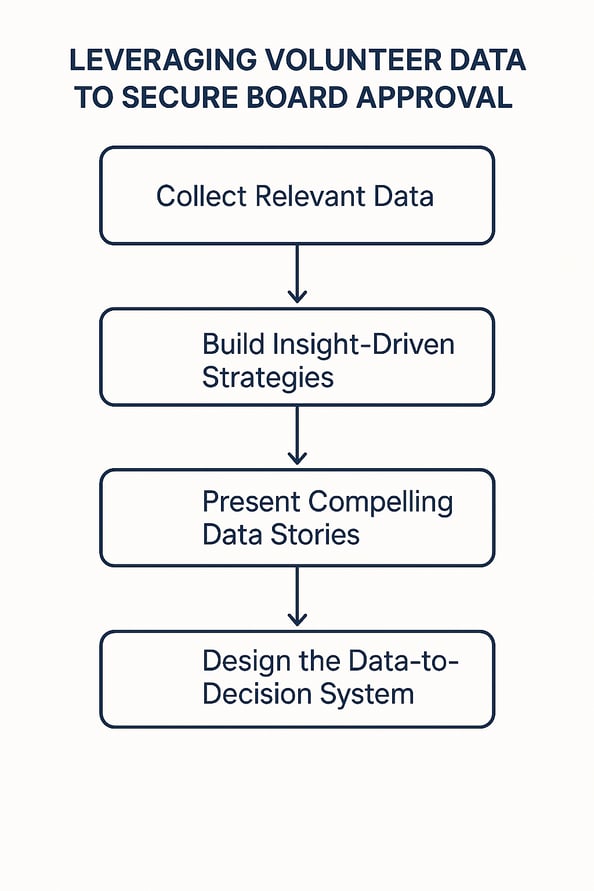How Volunteer Data Can Elevate Board Meetings and Increase Buy-In
Every nonprofit leader has felt it: standing before the board, presenting an initiative you know can make a difference, fueled by genuine passion and compelling stories. But as soon as the question comes—“How does the data support this?”—you realize stories alone won’t secure the green light. Today’s board wants more than inspiration; they expect clear metrics, measurable outcomes, and proof that each new proposal is a strategic investment in your mission, backed by evidence rooted in your volunteer program’s impact.
Here’s the opportunity: Your volunteer data isn’t just a collection of numbers—it’s a catalyst for real change. Used strategically, it evolves into your most compelling tool for building board confidence and unlocking essential resources, empowering your program to reach new heights.
Every volunteer coordinator faces this reality—often only recognizing its significance when the stakes are highest: your volunteer data goes far beyond what’s captured in spreadsheets. When put to work intentionally, it becomes your strongest advocate, inspiring genuine board enthusiasm and driving organizational momentum forward. A well-crafted data narrative holds the power not just to earn approvals, but to transform hesitation into collaboration, propelling conversations from “maybe next year” to “let’s start now.”
Modern volunteer management software has made collecting and analyzing this data easier than ever, but knowing what to collect and how to present it makes all the difference.
Why Boards Prioritize Actionable Volunteer Data
Board members operate in a world defined by fiduciary responsibility, risk assessment, and a laser focus on return on investment. When they request data, it’s not a critique—it’s due diligence. Volunteer programs represent significant investments: staff hours, training budgets, insurance, and digital infrastructure. In fact, if you quantify volunteer hours using standard rates such as those published by Independent Sector, your volunteer program could easily emerge as one of your organization’s largest “budget lines.”
What sets volunteer data apart is its unique ability to connect mission impact to organizational excellence. When you demonstrate that 500 volunteer hours devoted to your youth mentoring initiative translated into a 40% increase in participant outcomes, you’re doing more than defending the value of your volunteer program—you’re showcasing the overall effectiveness and credibility of your entire organization.
Escaping the Data Collection Trap
Before diving into specific tactics, let’s address a common challenge: most organizations are overwhelmed with volunteer data but lack the actionable insights needed to drive real decisions. You may be tracking hours, roles, event participation, and using everything from spreadsheets to volunteer management dashboards. Yet, when the board requests key metrics, it’s often a scramble to assemble meaningful answers.
The issue isn’t scarcity of data—it’s a gap in collecting the right data strategically. Start by clarifying what decisions your board needs to make this year. Are you requesting budget approval for an additional volunteer coordinator? Proposing program expansion into a new community? Justifying continued investment in underperforming initiatives? Each of these requires unique data points.
Work backwards from each key decision. If you need support for new staff, gather data that demonstrates volunteer retention rates, the current administrative load, and how improved coordination impacts volunteer satisfaction. If you’re recommending expansion, focus on geographic distribution, data reflecting community needs, and metrics around capacity.
By aligning data collection with critical decisions, you’ll ensure every report you deliver to the board is both relevant and persuasive—transforming information overload into strategic clarity.
Stop collecting everything. Start collecting what matters. Modern reporting tools make it possible to generate targeted reports that answer specific board questions without drowning in unnecessary details.
The Three Data Stories Boards Can't Ignore
Story One: The Efficiency Narrative
Boards love efficiency because it speaks their language: maximum impact per dollar invested. Your volunteer data can tell this story brilliantly. Calculate your volunteer return on investment by comparing program costs against volunteer hour value. When you can demonstrate that every dollar invested in your volunteer program generates eight dollars in volunteer labor value, you're speaking ROI fluently.
Consider a youth services organization that tracks volunteer engagement trends over time. By analyzing retention data, the team identifies a clear pattern: volunteers who complete an enhanced onboarding and training program tend to stay significantly longer than those who receive only basic orientation. The data might show that trained volunteers remain active an average of three additional years—representing more than $45,000 in added volunteer value per person.
These insights illustrate how upfront investment in volunteer development can pay off exponentially. By linking training initiatives to measurable outcomes like retention and value, the organization builds a compelling case for continued—or even expanded—funding. In this example, that single data point could easily justify doubling the training budget, not as a cost increase, but as a strategic investment in long-term impact.
Track volunteer productivity metrics too. Are volunteers accomplishing tasks faster with your new systems? Are they taking on more complex responsibilities over time? These indicators prove program maturity and operational excellence—music to any board member's ears. Understanding what drives volunteer retention helps you collect and present the metrics that matter most.
Story Two: The Impact Amplification Case
Here's where volunteer data becomes transformative. Connect volunteer engagement directly to mission outcomes. This requires integrating your volunteer data with program results, but the effort pays enormous dividends.
For instance, imagine a regional food bank that uses volunteer management data to differentiate between distributions supported by volunteers and those staffed solely by employees. The data might reveal that volunteer-supported distributions enable the team to reach 35% more families and deliver noticeably higher client satisfaction scores. Instead of leading with a generic request for “more volunteers,” the coordinator could present a data-driven case: “By expanding our volunteer capacity in these targeted areas, we can serve an additional 1,500 families.” Equipped with these insights, the board would recognize the tangible impact and be more likely to approve the necessary funding.
Identify direct links between levels of volunteer engagement and measurable program outcomes. Are mentee success rates higher in programs with volunteer mentors? Do initiatives with ongoing volunteer involvement display stronger impact metrics? Establishing these correlations elevates your volunteer program from a supportive resource to an indispensable driver of mission success.
Story Three: The Community Connection Proof
Boards increasingly recognize that community buy-in is more than just a “nice-to-have”—it’s foundational to long-term organizational sustainability. Accurate volunteer data powerfully demonstrates the level of community investment in your mission. When your reports show that 300 community members are consistently giving their time, you’re providing direct evidence of grassroots support—exactly the type of engagement that donors and funders are eager to see.
Use your volunteer management tools to map volunteer demographics against those of your broader community. Are you connecting with and engaging diverse populations? Do your volunteers reflect the communities your organization aims to serve? By tracking this data, you’re equipped to address critical questions about equity and inclusion—topics that are increasingly central to board-level conversations and compliance requirements.
Track volunteer-to-donor conversion rates. Many boards don't realize that volunteers become donors at significantly higher rates than the general public. When you can show that 40% of your volunteers also donate financially, and that volunteer-donors give 60% more than non-volunteer donors, you're making a development case, not just a volunteer program case.
Data That Engages and Inspires Action
Transform your data presentations into powerful storytelling moments that resonate with your board. Board members are volunteers, too—honor their time and attention by making every slide count.
Lead with the impact headline. Instead of opening with “volunteer hours increased 23% year-over-year,” capture attention with, “Last year, our community powered 5,000 additional volunteer hours to combat food insecurity—here’s what was achieved.” Let the data serve your story: share the outcomes first, then support with quantitative evidence.
Frame your data in ways the board can immediately grasp. Comparative context is key: rather than presenting numbers in isolation, highlight benchmarks, such as “Our volunteer retention rate of 68% surpasses the national nonprofit average of 55%,” or “We deliver impact at a cost-per-outcome that’s half the industry standard.” Boards assess data through a lens of relative performance—help them see precisely where your program stands.
Be intentional with visuals. A single, thoughtfully crafted chart or map can communicate organizational reach or spotlight service gaps far more effectively than a sequence of tables. For example, overlaying volunteer distribution on areas of need tells a strategic story at a glance, making your case instantly clear.
Anticipate and address questions up front. If you’re proposing an investment, proactively present data around potential risks and mitigations. Share results from pilot programs, reference sector best practices, or outline phased rollouts supported by clear metrics. When concerns arise and you’re ready with, “Great question—here’s what the data shows,” you’ll build immediate board confidence and momentum for your proposal.

Designing the Data-to-Decision System
Don’t wait for board meetings to address your volunteer program data strategy—build a proactive, quarterly data review process focused on the volunteer metrics that inform upcoming organizational decisions. This forward-thinking rhythm ensures you’re always prepared to answer board questions with confidence and clarity.
Set clear benchmarks and monitor progress consistently. Boards want to see long-term trends, not just one-time snapshots. Early numbers might show areas for growth—but sustained tracking enables you to demonstrate momentum and improvement over time, bolstering board trust in your programs.
Develop a streamlined, easily-updated data dashboard, highlighting four to six key metrics aligned with your strategic objectives. When board members have access to meaningful, regularly refreshed insights, they gain a natural intuition for your program’s dynamics. This shared understanding turns every future proposal into a story with recognizable milestones and context. Leading volunteer management platforms like VolunteerHub can automate much of this reporting, delivering accurate reports without requiring hours of manual work—helping you focus on advancing your mission, not just formatting spreadsheets.
From Approval to Advocacy
The ultimate sign that you’ve embedded a data-driven mindset within your board? Board members become genuine advocates for your volunteer program—proactively championing initiatives, referencing your key volunteer metrics in external conversations, and linking your data to high-level strategic opportunities. They’re equipped to defend your budget line items confidently, sometimes even before you present the case.
This transformation occurs when data becomes a common language between staff and board—no longer just a reporting requirement, but a catalyst for strategic conversations and organizational alignment. When your volunteer metrics are accurately captured and meaningfully presented, they do more than inform decisions. They influence your organization’s culture, amplify the visibility and value of your volunteers, and reinforce your mission with the human capital needed to sustain growth.
So, as you prepare for your next board meeting, remember: you’re not simply reporting on numbers. You’re crafting a narrative of community impact, operational excellence, and mission-aligned strategy. Your volunteer data is the evidence that bridges aspirations and actionable outcomes—transforming ambitious proposals into fully funded initiatives.
Ultimately, the board isn’t just asking, “What does the data say?” They want to know, “Is this truly worth pursuing?” By presenting a compelling data story, you’ll not only build consensus—you’ll inspire commitment and shared vision.
Ready to transform your volunteer data into board-winning insights? VolunteerHub's reporting tools make it easy to track, analyze, and present the metrics that matter most to your organization. From standard reports to custom reports, our platform helps you spend less time wrestling with spreadsheets and more time making data-driven decisions that advance your mission.



